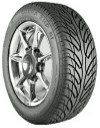 | home
| homePrice List For Tiny's Auto | Belts & Hoses | Cooling System Flush | Maintenance | Coupons | Additives | Tune Ups | Brakes | Tires | Timing Belts | Chassis | Cooper Tires | Schedule An Appointment
Tires



Tire Rotation
Why should I rotate my tires?
If you never rotate your tires, the fronts will last about 10,000 to 20,000 miles and the rears will last 50,000 to 80,000 miles. The reason We rotate tires is to even out the wear and properly done, all the tires will be worn out at the same time. It's also a great excuse to inspect your brakes on a regular basis.
When and how should I rotate my tires?
It is important to rotate your tires to even out the wear. The front tires will wear the outside edge because the tire leans over when you turn a corner. Slight outside edge wear that appears to be the same on both front tires is no reason to be alarmed. If you find one of the front tires has significantly more wear than the other, then there is cause for alarm. The rear tires just follow the fronts so their wear is minimal.
It is very important to rotate your tires every 6,000 to 7,500 miles. Three things should occur during a tire rotation. First, all the tires should be properly inflated. Second, the tires should be rotated. Third, a physical inspection of the brakes should be made while the tires are off. It make no sense to pay to have your brakes checked, then 3 months later pay to have your tires rotated.
A lot has been written about the proper way to rotate tires. The biggest portion of the discussion is whether or not it is OK to change the direction of the rotation of the tire. If a tire is moved to the other side of the car, the direction of rotation has been changed. Years ago that was a no-no but now many tire makers recommend the crisscross way.
Different tire manufacturers may suggest different ways and if you want to be entirely correct, check with the maker of your tires.
In my opinion, you may rotate straightforward and straight back or you can crisscross the fronts and/or the backs before you rotate. At our shop we rotate our customers tires a variety of ways depending on the wear pattern on their tires.
If the tire is scalloped and causing a whine or hum at higher speeds, we will change the direction of rotation to help even out the wear.
Scalloped tires are often used as a reason to sell shocks or struts. The Shock or Strut has a micro amount of free play. This causes the tire to bounce or Scallop. I have found the only way to get rid of this problem is to replace all 4 tires and Shocks or Struts.
Don't forget this one important point. Once a tire begins a wear pattern, it will continue with that pattern until you throw the tire away or it wears out. So if you install new tires and one of the front tires starts an abnormal pattern because of an alignment problem, having an alignment done will fix the cause but not the tire.
Make sure to check your spare at least once a year. A four-tire rotation should cost $10-20 dollars. And up to $40 for a rotate and balance.
How much air should I carry in my tires?
There are three different places tire inflation information can be found. Your owner's manual will deal with proper tire inflation, there may be a tag describing proper tire inflation procedures in the drivers door area, either on the door or on the jamb or there is inflation information on the sidewall of the tire. Don't be surprised if all three don't match.
The inflation information on the tire will describe the maximum inflation of that tire cold. This is the best pressure the tire should ever be aired to. The owner's manual may describe a slightly lower inflation number. Anywhere in between will be fine for any car or SUVA or light truck. But remember this:
Using the higher inflation numbers (35-44 psi) will keep the tire cooler, give you better fuel economy but you will sacrifice ride quality. The ride of the car will be harsher than with softer tire pressures.
Using the lower inflation numbers (28-35 psi) will give you a soft, smooth ride but your tires will run hotter and your fuel economy will be between 1-5% less than with fully inflated tires. Also I find that when tires are underinflated they tend to wear out on the edges must faster.
I always inflate my customer's tires to the maximum inflation figure written on the side of their tire. The only exception is a "Z" rated high performance tire, like ones on a Corvette, Camaro, and 300ZX. I don't inflate them to their maximum of 44 psi, but use 40 psi as an upper limit on these tires. Otherwise the ride is way too harsh.
Now I have found that the 17", 18" 19" and larger wheels have tires that need 60 psi. and up. You really have to stay on your toes when airing tires, so you wont damage a customers wheel. Keep this in mind when you go for your vehicles maintenance. Tell them you want the tires inflated to the tire manufacturers recommended max. inflation. Again you can find this on the side wall of the tire. Remember that the vehicle manufacturer wants you to under-inflate tires so you have a soft ride. This is bad for your tires. Just ask Ford And Firestone.
Send mail to E-MAIL with questions
or comments about this web site.
Copyright © 2011 Tiny's Auto & Truck Repair Service
Last modified: 03/11/2003